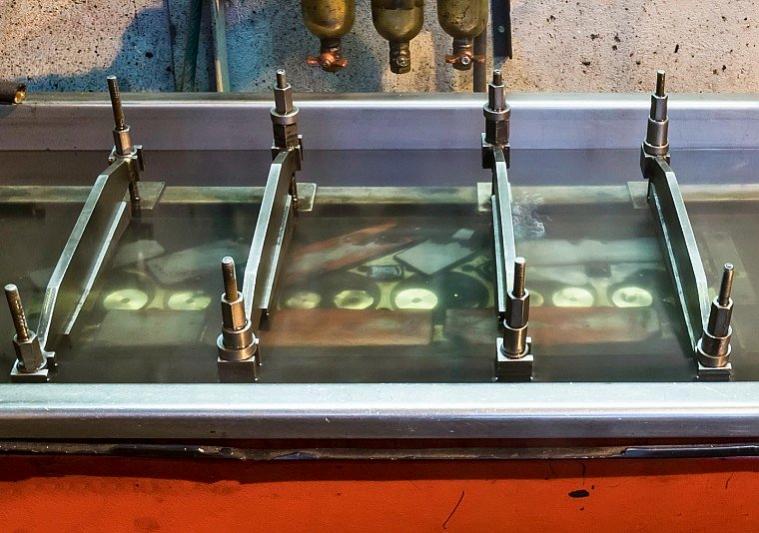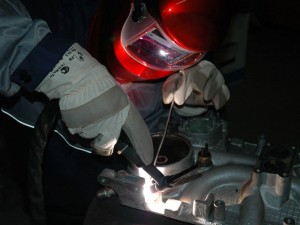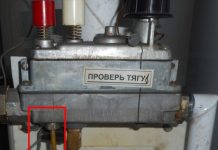You can also weld on a patch, for this you need tin-wrapped copper electrodes. Finally, the seams must be covered with epoxy paste.
The epoxy paste that we have already mentioned can be used to repair cracks in the head and engine block in another way. To do this, it is necessary to clean their surface, drill small holes at the ends of the crack, then cut a thread into them and screw in flush plugs made of copper or aluminum. Then it is necessary to degrease the surface (acetone or gasoline is suitable for this). Then, using a spatula, you need to apply layer by layer, as a result, you should get a layer 3-4 millimeters thick. After that, the epoxy should harden within a day, and if you create a centigrade heat, it will harden in a couple of hours. Finally, sand the surface and you're done!
For the third method of eliminating cracks, we again need epoxy paste and fiberglass, which we will use as a patch. The preparatory stage for work is similar to that presented above, only each layer of paste must be alternated with fiberglass. Do not regret making the patch with a margin of a few millimeters, otherwise the result will be unsatisfactory. The last coat must be epoxy.
And the final option for today, but not the last in the general list, is the option of reanimating cracks in the block and the engine head - with the help of pins. To do this, at the very beginning, along the entire crack, we drill holes at a distance of 7-8 mm from each other. We cut the threads and screw in the copper rods to a depth corresponding to the wall thickness. Then we cut them off with a hacksaw, leaving the ends protruding above the surface of the part by a few millimeters. After light blows, rake out the ends of the pins, which form a continuous seam. To consolidate the result, in the end, you can cover it all with epoxy.
We have described the most suitable options for self-repairing cracks in the head and engine block, however, unfortunately, the troubles with the car do not end there, problems can still arise when the camshaft is worn out, as well as when the shock absorbers are worked out. In any case, do not despair, all this can be easily eliminated with your own hands, only by following our simple recommendations.
VIDEO
Tell me how to fix the crack in block d-240. The crack goes along the bottom edge of the block (where the pallet sticks). I took a GAZ 53 with this engine, but overlooked a pancake. Maybe someone tried what kind of chemistry? Someone tried to cook the crack with cast-iron electrodes - give a shit, but the problem has not been solved.
And it cannot be solved by welding.In principle, this is what they do "shit" from the outside with a semiautomatic device, and from the inside they are sealed with a special sealant.
Cook. and how to cook with ordinary electrodes! There was also a problem brewed up and everything is ok! This feature can d240 even in the instructions, this process is described ..
cast iron on d-240 is bad. in terms of welding. to the advice given by RULJA, you can add the recommendation to drill out the edge of the crack - and thereby prevent its further growth. if the water jacket is intact, it is better not to cook at all - it is enough RIGHT to use high-quality cold welding. If there is only a crack on the water jacket, then to the above I would use (and successfully apply) CERAMIC SEALANT OF THE COOLING SYSTEM of the HI-GEAR company - for a year MAZ with antifreeze! enough.
if we are talking about adhesives and sealants, then I am for poxipol.
I don’t know how anyone, but we cooked a pig iron with a mobile device with ordinary electrodes. All the gut was :-)
At the Nikolsk Engine Repair Plant, I saw that cracks in the blocks were repaired by installing metal patches. The crack was cut, drilled, a patch was made from a steel sheet about 2 mm thick, holes were drilled and cut into the block for M6 bolts and the patch was screwed onto the crack through a cardboard gasket onto some red sealant.
how can you understand the definition of "ordinary electrode"?
how can you understand the definition of "ordinary electrode"?
well, probably those that are sold in stores ..)))
Aren't there any “unusual” ones in the store? Perhaps "unusual" cast iron will be better cooked, do you think?
Well, it's necessary to look for this)))) so my block was cooked with special electrodes. on cast iron.
Electrodes for welding cast iron, as well as ordinary electrodes (mr, uoni, ano), wrapped with a copper sponge, do not prevent the bleaching of the heat-affected zones. therefore, successful welding of cast iron (except for ductile iron) without subsequent difficult heat treatment is rather an exception. The use of the above recommendations is the only way out, even though it is handicraft
no, all these weldings are from the evil one. Personally, I would not dare to cook myself a block. If I would have gone for it, it would be gas-flame brass brazing. And even with her, not everything is so smooth, and welding is so even more so. Cast iron welding takes place on small, non-critical, low-loaded parts. And then to call it welding the tongue does not rise.
no, all these weldings are from the evil one. Personally, I would not dare to cook myself a block. If I would have gone for it, it would be gas-flame brass brazing. And even with her, not everything is so smooth, and welding is so even more so. Cast iron welding takes place on small, non-critical, low-loaded parts. And then to call it welding the tongue does not rise.
Well Duc a new unit is certainly good BUT, not everyone can afford it. That from the evil one I also agree.
block is certainly not a cheap thing, but plus everything and a headache with registration. So it is more economical to carry out repairs, but it will not be reasonable to cook something that a priori is not cooked in the full sense of the word. Now there are a lot of polymers on sale with which you can quickly and cheaply seal a crack, having previously removed the stress concentrates in order to stop the progression of the crack itself. In principle, there are many ways to eliminate this problem, including the application of a weld, but the risk of doing "business" is very great and one should not forget that a block is a critical part with certain loads and a given geometry, the slightest violation of which will lead to disruption of the work of others parts and the whole engine.
When eliminating cracks on the cylinder block, the most widespread method is welding without preheating and repair using pastes based on epoxy resins.
The design features of the cylinder blocks of the YaMZ-236 and YaMZ-238 engines make it necessary to abandon the welding of cracks by the general preheating method, since this method causes large deformations in the block.
Regardless of the accepted repair method, the ends of the crack are drilled with a drill with a diameter of 4 mm, after tilting the drilling site, and the crack is cut along the length with a metal chisel at an angle of 120 ° to a depth of 0.7-0.8 mm of wall thickness. The crack is then sanded with a grinding wheel using an electric flexible shaft sander.
Cracks are welded with direct current with reverse polarity with an OZCH-1 electrode or a copper-steel electrode with UONI-13 coating. The diameter of the electrode is selected depending on the thickness of the walls to be welded within 3-5 mm. Welding is carried out with light hot forging of the seam as individual sections of the seam are applied.
If there are breaks on the plane of the oil pan attachment with a chisel and a grinding wheel, the break point is cleaned and a 4x45 ° chamfer is removed at the edge of the break for welding the insert.
As an insert, a similar part from a waste block or a cast-iron insert, fitted in place, with subsequent welding and surfacing of the breakage point to the original contour with an allowance of 1.5-2 mm for processing, can be used.
Welding and surfacing are performed with a GS-53 gas torch with tips # 2 or # 3. The filler material is a gray cast iron rod with a diameter of 8-10 mm or a gray cast iron rod with a content of 2.5% silicon. Borax serves as a flux. Then, with a grinding wheel or file, they clean the weld seam and the place of surfacing flush with the base metal.
If a crack or breakage captures the hole, then after welding and stripping, mark the hole according to the template, screw the center and drill the hole, followed by threading to the nominal size.
When sealing cracks and holes on the surface of the cooling jacket and the crankcase of the cylinder block, epoxy pastes of the following composition are most widely used:
Among the breakdowns
Blocks and heads of engine blocks are composed of various metal alloys. Technologies existing today often make it possible to restore damaged elements. Next, we will look at ways to eliminate the breakdown and answer the question of how to remove cracks in the cylinder block and repair cracks in the cylinder head. In some cases, repair of cracks can be done by hand.
One of the most widely used methods of eliminating cracks in the cylinder block and cylinder head is the sealing of defects in silumin and cast iron blocks by welding.
The following methods are used to detect cracks:
ultrasonic detection method;
In practice, the detection of cracks in many car services is carried out by pumping air or water into the faulty element of the engine. In the case of air, the part is additionally immersed in a bath and defects are found by bubbles. If water is pumped into the element, then the need for immersion is eliminated, since cracks are diagnosed by fluid seepage.
To determine the exact boundaries of the crack, a pair of magnets are attached on both sides of the split, the space between the magnets is covered with special conductive sawdust. The presence of a crack will cause the lines of the magnetic field to break, sawdust will partially cluster on the surface of the split. This method allows you to clearly identify a crack in the cylinder block or cylinder head.
It should be noted that splits should be eliminated in strict accordance with all recommendations. Residual mechanical stresses in the seam zone can lead to violations of its integrity and the need for repeated repair.
The cast iron block is repaired by drilling the ends of the crack and then grinding the entire length of the split at a 90 degree angle. Drilling is necessary in order to prevent further spread. When it comes to welding, initially the cylinder block heats up to 650 degrees Celsius.After that, a continuous seam is applied using a filler cast iron - copper rod and flux. The final stage is the gradual cooling of the part, which requires a special oven.
To begin with, minor cracks can also be repaired by using epoxy paste and fiberglass. Before starting work, the metal surface must be well degreased. Layers of paste and glass cloth alternate during application, the last layer should be epoxy.
Among the technologies most in demand today, it is also worth noting a solution called SEAL-LOCK. The advantages of this method include the absence of the need to dismantle the engine. The method is suitable for repairing serious holes or cracks in the cylinder block. Also, the repair does not require the use of a welding machine.
The method is based on filling the crack with a special layer of soft metal, which, as a result, is securely attached to the surface of the part being repaired.
The crack is localized, after which the edges of the split are drilled. Next, holes are drilled across the crack with a set technology step. Staple ties are inserted into these holes, which tie both edges of the crack. The staples are selected in accordance with the type of split, as they can have different lengths and differ in their shape.
As for the installation of large patches, with which you can literally "glue" a cracked engine block or a block head, then the solution method according to the implementation scheme resembles that described above.
What is the best sealant for a car engine?
Regardless of which metal alloy is used in the manufacture of the block, over time during operation, a crack can form in the engine block.
Visually it is possible to identify deep breaks, but microcracks cannot be identified "by eye".
To finally make sure that microcracks are formed, there are several ways to identify defects.
The magnets are installed on the body of the device or the cylinder head. Metal shavings are poured on top. It begins to move to the places where the magnets are installed, hammering into cracks.
On the cylinder head surface thoroughly washed with acetone or kerosene, apply a special liquid paint and wait 10 minutes. After that, wipe off the remaining paint with a clean rag. Defects after such a method are detected immediately.
Liquid can be used to check the integrity. To do this, it is necessary to tightly close all openings and pour water into the channel. Using a pump, we pump air into the channel at a pressure of 0.7 MPa. We leave the block in this state for several hours. Leaving water will indicate that there are defects in the block head. In the same way, the integrity is checked by immersing the unit in a container of water. In this case, bubbles will show where the cracks are.
VIDEO
Locations of defects, for the elimination of which it is not worth undertaking.
on valve seats;
on the cylinder mirrors;
on the plane of contact between the block and the head.
Drill the cracks with a drill so that they do not go further and do not begin to grow during operation. Grind.
We heat the block up to 600-650 degrees. For sealing, we use a filler rod made of a cast-iron-copper alloy with a diameter of 5 mm and a flux. Protect the seam from oxidation with borax.
An even layer with a protrusion of no more than 2 mm should remain on the surface in the engine block. After that, we cool the unit in a heating cabinet.
In this case, heating of the block is not required. Electronic wire is used as filler material. Argon is used as a welding medium. Do not overheat over 60 degrees.
We heat the head to a temperature of 200 degrees. We use an acetylene torch for this. The sealing is done using direct current. The diameter of the electrode is selected depending on the width and thickness of the wall.
We select a piece of metal the size of a crack. We wrap the copper alloy electrodes with a tin can and weld the patch. Sand and finish with epoxy paste.
Cut the fracture by grinding and drill the ends of the cracks with a drill, no more than 85 mm in diameter. Insert copper plugs into the holes. We traverse the outlines of the cracks with a notch to create an artificial roughness.
We degrease the surface using acetone, heat it with an infrared lamp to a temperature of 80 degrees. Apply epoxy paste to the fault in the following sequence:
1 layer 1 mm,
second 2-3 mm,
the third is 3-4 mm.
Withstand for 24 hours at a temperature of 20 degrees, then it is necessary to dry the repair site in a drying chamber, at a temperature of 90 degrees, for one hour.
VIDEO
After drying, clean the bonded area and level with sanding.
Hello! Cracks in the engine block are, of course, very sad, and such a malfunction can form absolutely at any time!
It is advisable to diagnose and eliminate such malfunctions immediately and without delay. Cracks can be removed well by welding. Therefore, I want to ask, is it possible to weld cracks in the cylinder head? How severe should the faults be? Are there any rules for welding?
Cracks can be closed by welding only under conditions:
Cracks in the cylinder head are electroweldable. The ends of the crack are drilled and grinded. This is done in order to avoid its further growth. Next, using an electric welding device, we put a weld into the recess.
What if there is a crack in the cylinder head between the valves? Should you brew yourself? Maybe it would be much safer to go to a service center?
Incidentally, I completely agree with you. Do not handle the cylinder head with your own hands. By the way, what can the boss crack from? As a rule, from sudden changes in temperature, as well as if cold water was poured onto an overheated engine.
Cracks of the size and location that you have shown can be completely repaired by yourself without resorting to the help of auto repairers. In this case, electric welding and pre-drilling are applicable. You will also need flux and a metal substrate for welding.
If the crack width does not exceed 0.1 cm (and with this width it will not be long), then it should not be welded. For one simple reason that during welding the quality of the metal decreases and cracks may form around the weld!
There are several methods for eliminating cracks in the internal combustion engine block:
1. Electric welding with hardening of the crack edges. In principle, they figured out what it is, I agree, correctly described; =)
2. Copper electrode + epoxy resin. Used when welding a metal patch to the crack. The size should be more impressive. Welding takes place with electrodes, and epoxy as a reinforcing component is placed on the seams;
3. Epodoxide resin. We just cover up the cracks and heat it;
5. Method of pins. We drill holes along the entire crack at a distance of 5 mm from each other. We screw in the copper pins, and then bend them together. The resulting metal layer is coated with epoxy resin.
The latter method of elimination with pins is not very effective. And it gives off the Soviet past. It is much easier and faster to weld the crack.
I disagree with you. It was the last method that seemed to me the most successful. The main thing in it is accuracy, which consists in cutting pins of a certain thickness and carefully drilling them in. Putting only epoxy resin will not give any results at all, the composition will quickly fall off.
Video (click to play).
One of the most important steps is degreasing and cleaning the surface. If this is not done, then the resin will naturally fall off, and the welding will be done poorly. This is the first rule.











